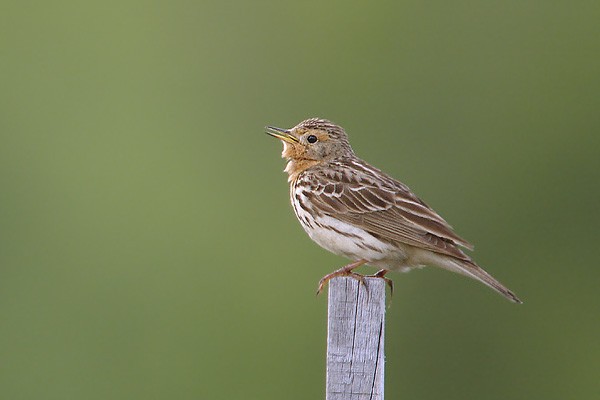Red-throated Pipit
A species of Pipits Scientific name : Anthus cervinus Genus : Pipits
Red-throated Pipit, A species of Pipits
Botanical name: Anthus cervinus
Genus: Pipits
Content
Description General Info
 Photo By Daniel Pettersson
Photo By Daniel Pettersson Description
This is a small pipit, with adults easily identified in the breeding season by their brick red face and throat. In other plumages this is an undistinguished looking species, heavily streaked brown above, with whitish mantle stripes, and with black markings on a white background below. It is very similar in appearance to the meadow pipit and in the autumn it much resembles the tree pipit but has an altogether more striped appearance because of the larger numbers of streaks on the cap, back, flank, rump and chest. The flight of the red-throated pipit is strong and direct, and it gives a characteristic psii call as it flies. 
Size
15 cm
Colors
Brown
Gray
White
Life Expectancy
1-5 years
Nest Placement
Ground
Feeding Habits
Red-throated Pipit primarily consumes insects, foraging on the ground with a preference for open spaces. Its dietary adaptations include a keen sense for detecting prey in grassy habitats.
Habitat
Red-throated Pipit breeds in the tundra with willow mires, sedge marshes, and scattered peat mounds. Known to migrate through agricultural fields, red-throated Pipit's non-breeding habitats include wet grasslands, marshes, riverbanks, and coastal flats, often impacted by cattle. It inhabits elevations up to 2500 meters in East Africa, occasionally above 3000 meters, sharing territories with Motacilla flava.
Nest Behavior
Males begin nest construction by scraping a hollow. Females build the nest with materials brought by males. Nesting includes flight-songs and courtship displays, leading to egg-laying and shared parental care.
Nest Characteristics
The red-throated Pipit's nest is a ground-based cup located against hummocks or sheltered by rocks/shrubs. It's constructed from grass, leaves, moss, and lined with finer grass, animal hair, or feathers.
Dite type
Insectivorous
General Info
Feeding Habits
Bird food type
Sounds
Call
Recording location: Ethiopia
Behavior
The red-throated pipit is native to the boreal regions of northern Europe and Asia. The breeding habitat is open country including mountains, marshland and tundra. The nest is built on the ground, often beside a tussock of grass, on rough grassland or on a hummock in a marsh. It is made of dry grasses and sedges with a soft lining of reindeer hair or down. Four to six eggs are laid and incubated by the female for nearly two weeks. The young are fledged and ready to leave the nest about twelve days later. The red-throated pipit is insectivorous, like its relatives, but also eats seeds. 
Species Status
Not globally threatened.
Scientific Classification
Phylum
Chordates Class
Birds Order
Perching birds Family
Wagtails Genus
Pipits Species
Red-throated Pipit